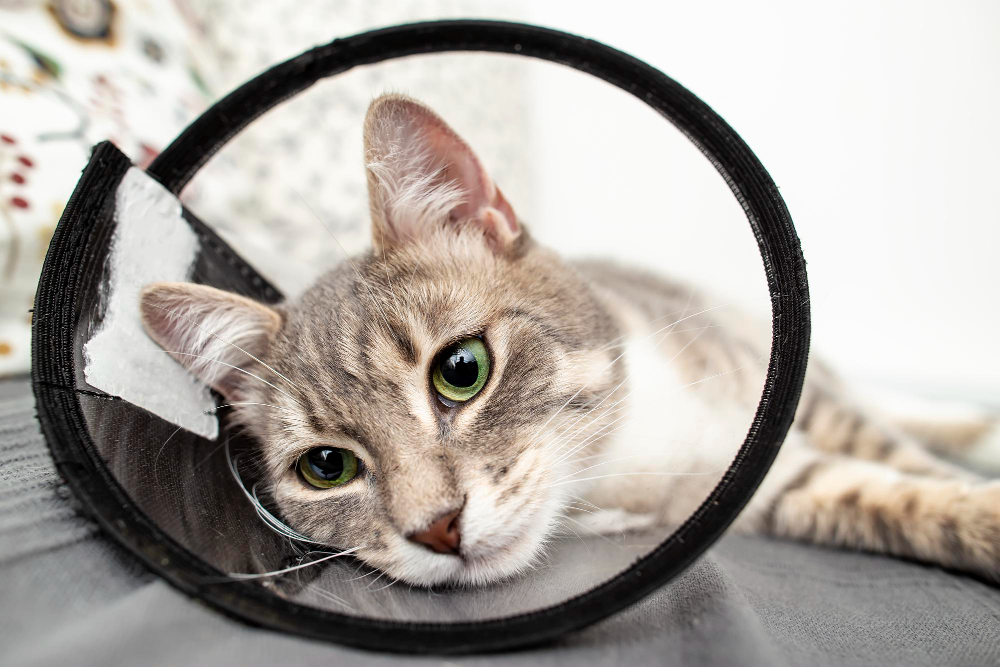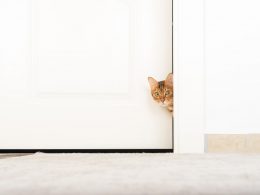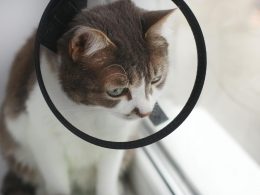Cones don’t bother some cats at all, while they freeze or have difficulty moving about usually when they first put one on. However, cones aren’t a death sentence, and you can do a few things to help your cat get used to them and feel more comfortable as they heal.
Take some time each day before your cat’s scheduled surgery to desensitize them by using a cone to help them get used to it, and make sure they know how to go about their routine while it’s on.
Even if they must wear one immediately, the techniques outlined below can help ease the transition. Using calming feline pheromones is also an option if your cat is sensitive to change or has a high energy level.
A cone keeps your cat from licking the incision made in his scrotum. While it may be uncomfortable for your cat, the chance of infection is minimized.
Even if your cat is wearing a cone, several methods to make their experience more enjoyable. If you’re familiar with your cat, you’ll know exactly what goodies they appreciate, where they want to be rubbed, and how much attention they need.
Can I Leave My Cat Alone with a Cone?
Putting a cat in a cone of shame after a visit to the vet is a cat’s worst nightmare. Cats wearing cones are known to suffer from depression, which is understandable.
Cones can be uncomfortable and perplexing for anyone forced to wear one, whether due to a medical procedure or because they have a condition that necessitates them.
As you can imagine, your cat would not enjoy the experience of wearing a cone. We’d be the same way. However, you must keep an eye out to ensure that this feeling of unease does not develop into despair. While some cats can put up with the discomfort, it can be not very pleasant to others.
If your cat behaves in an uncharacteristically depressed manner, you should do everything you can to help them. However, if you suspect your cat’s behavior is out of control or compromising his health, you should discuss it with your veterinarian.
Make sure the cone you choose is not too small or too large for your cat. The cone should also be neither too small nor too large, so the patient cannot access their wound or surgical site while wearing it.
Can Wearing a Cone Make a Cat Depressed?
After a recent trip to the veterinarian, your pet is sporting a new look: the dreaded cone of shame. In addition, your pet is depressed because of the cone meant to protect their stitches.
Even if your cat is wearing a cone, several methods to make their experience more enjoyable. If you’re familiar with your cat, you’ll know exactly what goodies they appreciate, where they want to be rubbed, and how much attention they need.
First, use this technique to keep the cone in place and prevent it from moving about too much in the neck. Next, tie the cone to their collar with gauze or a delicate string to avoid irritating their skin.
When a cat wears a cone, it’s no surprise that it’s not the happiest animal on the planet. However, what you can do as their owner is encouraged and cheer them up while your cat wears a cone of shame until they recuperate.
Consider implementing some of the above-mentioned ideas to make your cat’s cone-wearing experience more pleasant for him or lift his spirits if they are feeling down. If you’ve tried everything and your cat isn’t improving, it’s worth talking to your vet about your alternatives.
Should I Leave the Cone on My Cat at Night?
The best way to get your feline pet used to wear the cone is always to leave it on. However, even if you feel sorry for your pet and take the cone off, your pet may see this as a punishment and try to destroy it when you leave.
Complaints include that cats won’t eat, bang into the walls, grow unhappy, and excessively brush the cone. As a result, these cats may not be able to get a good night’s rest because the collar supports their head and face up.
When asked about their pets’ experiences while wearing the cone, most owners said that their pet was “depressed,” had trouble eating, and the discomfort was worse than the activity designed to prevent. In addition, some animals could not jump or generally walk while wearing cones in some circumstances.
On the bright side, owners reported that the cone of shame worked to keep their cats from engaging in undesirable behaviors like licking or biting. Particular cats can be trained to wear a collar, but this is not a strategy that most owners can follow; the collar needs to be put on immediately, not after the pet has become accustomed to it.
How Can I Make My Cat More Comfortable with a Cone?
Cones are used to stop cats from licking or gnawing certain parts of their bodies. In addition, an anti-chewing medication can be used to prevent cats from eating their wounds or self-inflicting wounds.
It would help if you only used a cat cone to stop a cat from clawing or licking itself. The first step is to take Kitty to the vet to receive a proper diagnosis and treatment for the underlying issue.
- To begin, ensure sure the cone is suitably sized for your cat. It can be harrowing for them to wear an incorrectly-sized cone. Two fingers should fit comfortably between the cone’s collar and the cat’s neck.
- To secure the cone to your cat’s collar, you can utilize the holes in the bottom of the cone. Keep the cone in place and prevent it from moving about too much in their neck by using this technique!
- Cone-wearing cats should be kept away from staircases and other potentially dangerous situations. You may want to temporarily restrict access to dangerous areas like stairwells and other narrow passageways so they can’t get hurt or injured.
- Enjoying their favorite games is a surefire way to lift the spirits of a depressed cat. However, avoid anything too rigorous because they will still be recovering from their treatment when you do this.














